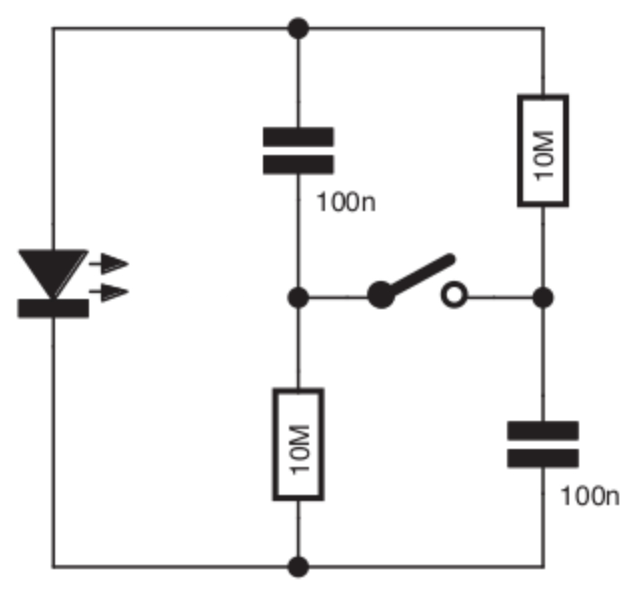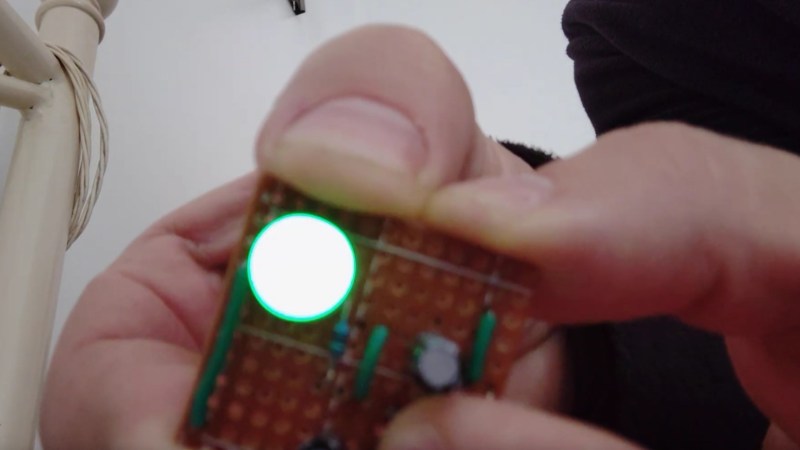[Tito] entered a Self-Charging LED Flasher into the Component Abuse Challenge. It’s a simple re-build of a design by the unstoppable [Burkhard Kainka], and while [Tito] doesn’t explain its workings in detail, it’s a clever experiment in minimalism, and a bit of a head-scratcher at the same time.
 You press a button and an LED flashes. But there is no battery, so how does it work? Maybe the schematic to the right here will help. Or does it confound? Look at it yourself before reading on and see if you can figure out how it works.
You press a button and an LED flashes. But there is no battery, so how does it work? Maybe the schematic to the right here will help. Or does it confound? Look at it yourself before reading on and see if you can figure out how it works.
The answer is that when the switch is open the LED functions as a small solar cell, drawing power from ambient light. This power is stored in the capacitors and released when the switch is closed! Pretty nifty.
We thought this circuit looked like fun so we took it over to the bench and put it together on veroboard. It took us a few goes to get it right. We used 100 nF ceramic caps to begin with, but didn’t get good results. So we switched to 1 µF polypropylene film capacitors and when we did that we got the circuit to work. It was possible to charge the circuit sufficiently using a mains powered LED lamp we have in the lab, a minute or so sitting in front of that charged the capacitors sufficiently to generate a flash. If you give this circuit a go yourself we’d love to hear how it went for you in the comments! (Editor’s note: Low leakage current in the capacitors is probably the trick.)
Of course we’ve seen plenty of self-powered circuits here at Hackaday before, such as this self-powered camera and this self-powered paper keyboard.
And if you haven’t checked out [B. Kainka]’s website, you’re missing out on enough weekend projects to last you for the rest of your life, if you live that long. (Translated from German here.) Some of his simple, yet brilliant, builds have even graced our pages here: this classic op-amp meower, or this clever radio receiver that uses an LED, biased by the PWM output of an ATtiny13, as a detector. Maybe [Burkhard] himself should enter the contest?

















The simple explanation is that the two capacitors are charged in parallel by the LED, then connected in series by the switch, which pushes current through the LED until the capacitors are half-discharged.
This is a simple charge pump that takes the voltage produced by the diode and doubles it for a short flash.
I’m guessing a green LED works best in the same way that plants are green, optimal absorption of light energy or something like that.
The plant appears green because they don’t absorb the green spectrum and reflect it. The green LED works the opposite, it’d absorb the green spectrum.
The plastic is just a filter for most LEDs.
Theoretically of the visible wavelengths, red LEDs should work best for this. They absorb any light with wavelength shorter than red.
Also don’t red LEDs have a lower forward voltage and use less power?
Yes but that should be counteracted by the fact that they generate less voltage in exitation because of the lower bandgap.
If I remember my high school biology classes, plants are actually the LEAST efficient color. Chlorophyll just generates enough energy that they can get away with it.